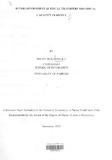| dc.description.abstract | This study examined the intergovernmental fiscal transfers and fiscal capacity in Kenya.
Its main objective was to analyze the horizontal imbalances in revenue collection within
local authorities in Kenya by identifying the determinants that contribute to higher
revenue collections in local authorities and analyzing the effects and significance of these
determinants on fiscal capacity. It is based on Dahlby and Wilson (1994) and Martinez -
Vasquez (1997a) modified efficiency model as an alternative to conventional fiscal
capacity measures. This model is drawn from optimal tax theory that seeks to minimize
social cost or excess burden by maximizing the social welfare function.
The study analyzed a sample of 22 local authorities using panel data for a period of 6
years (2001- 2006). Revenue factors were estimated using six variables (which included
contributions in lieu of rates, property rates, single business permits, market fees, other
revenue sources and intergovernmental transfers); and non-revenue factors that are
estimated using two variables (that is population of the local authority, and number of
employees working in the local authority).
Following the Hausman specification tests, the random effects model is found to be the
best fitted model. The results show that all revenue factors are significant and positively
related to fiscal capacity. Contributions in lieu of rates which is one of the local
authorities' source of revenue have the largest contribution to fiscal capacity. Secondly
municipal councils have higher revenue collection than the rest of the councils. Thirdly,
the results also show that there is no significant difference in revenue collected between
town council, county council and the city council. Lastly, local authorities with high
allocation of local authority transfer fund (LATF) tended to have higher fiscal capacities.
Generally, these findings support the fact that there are substantial differences in
horizontal imbalance among local authorities in Kenya | en |

